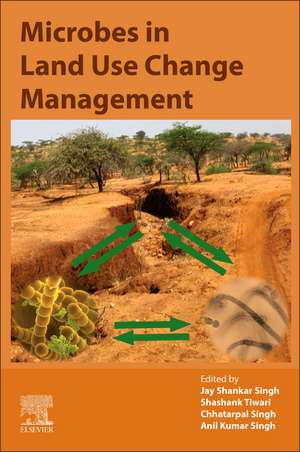Microbes in Land Use Change Management
Editat de Jay Shankar Singh, Shashank Tiwari, Chhatarpal Singh, Anil Kumar Singhen Limba Engleză Paperback – 25 aug 2021
Microbes in Land Use Change Management provides standard and up to date information towards the land use change management using various microbial technologies to enhance the productivity of agriculture. Needless to say that Microbes in Land Use Change Management also considers the areas including generation of alternative energy sources, restoration of degraded and marginal lands, mitigation of global warming gases and next generation -omics technique etc.
Land use change affects environment conditions and soil microbial community. Microbial population and its species diversity have influence in maintaining ecosystem balance. The study of changes of microbial population provides an idea about the variation occurring in a specific area and possibilities of restoration.
Meant for a multidisciplinary audience Microbes in Land Use Change Management shows the need of next-generation omics technologies to explore microbial diversity.
- Describes the role of microbes in generation of alternative source of energy
- Gives recent information related to various microbial technology and their diversified applications
- Provides thorough insight in the problems related to landscape dynamics, restoration of soil, reclamation of lands mitigation of global warming gases etc. eco-friendly way using versatility of microbes
- Includes microbial tools and technology in reclamation of degraded, disturbed and marginal lands, mitigation of global warming gases
Preț: 693.78 lei
Preț vechi: 881.60 lei
-21% Nou
Puncte Express: 1041
Preț estimativ în valută:
132.80€ • 144.30$ • 111.62£
132.80€ • 144.30$ • 111.62£
Carte tipărită la comandă
Livrare economică 14-28 aprilie
Preluare comenzi: 021 569.72.76
Specificații
ISBN-13: 9780128244487
ISBN-10: 0128244488
Pagini: 598
Dimensiuni: 152 x 229 mm
Greutate: 0.8 kg
Editura: ELSEVIER SCIENCE
ISBN-10: 0128244488
Pagini: 598
Dimensiuni: 152 x 229 mm
Greutate: 0.8 kg
Editura: ELSEVIER SCIENCE
Cuprins
1. Temperature sensitivity of litter and soil organic matter decomposition: perspective of soil microbial community structure and function
2. Adaptation of bacterial communities and plant strategies for amelioration and eco-restoration of an organometallic industrial waste polluted site
3. Effect of soil biofilms on ecological function and impact on soil properties
4. Alteration in microbial population density composition in different land use systems
5. Molecular characterization of bacterial community succession and analysis of physiochemical properties in a compost of solid organic waste from Gandhinagar, Gujarat, India
6. Molecular technologies for the early detection of fungal phytopathogens associated with cereal crops
7. Applicability of fungi in agriculture and environmental sustainability
8. Litterfall decomposition of selected plant species and nutrient
cycling in Madhupur Sal (Shorea robusta Roth) forest of Bangladesh
9. Bioactivity of soil microorganisms for agriculture development
10. Next generation OMICS: a tool to understand the diversity of soil microbiota and improvement of agricultural sustainability
11. Microbial associations in ecological reclamation and restoration of marginal lands
12. Assessment of microbial biomass for production of ecofriendly
single-cell protein, bioenergy, and other useful products
13. Participation and understanding of plant microbes’ interaction in plant health and growth by combating mercury stress: a sustainable approach towards agricultural practices
14. The role of plant growth promoting bacteria in mineralization of endosulfan and its metabolites
15. Response of microbial populations to landscape dynamics
16. Soil-plant-microbial interactions for soil fertility management and sustainable agriculture
17. Endophytic microbial interaction with legume crop for developing resistance against nutrient stress
18. Function-driven microbial genomics for ecofriendly agriculture
19. Role of microbial communities in restoration disturbed lands
20. Impact of microbial biofilm on crop productivity and agricultural sustainability
21. Valuing each patch of land: utilizing plant-microbe interactions for the betterment of agriculture
22. Tripartite interactions: plant-Pseudomonas putida-microRNAs in agricultural productivity
23. Next-generation omics technologies to explore microbial diversity
2. Adaptation of bacterial communities and plant strategies for amelioration and eco-restoration of an organometallic industrial waste polluted site
3. Effect of soil biofilms on ecological function and impact on soil properties
4. Alteration in microbial population density composition in different land use systems
5. Molecular characterization of bacterial community succession and analysis of physiochemical properties in a compost of solid organic waste from Gandhinagar, Gujarat, India
6. Molecular technologies for the early detection of fungal phytopathogens associated with cereal crops
7. Applicability of fungi in agriculture and environmental sustainability
8. Litterfall decomposition of selected plant species and nutrient
cycling in Madhupur Sal (Shorea robusta Roth) forest of Bangladesh
9. Bioactivity of soil microorganisms for agriculture development
10. Next generation OMICS: a tool to understand the diversity of soil microbiota and improvement of agricultural sustainability
11. Microbial associations in ecological reclamation and restoration of marginal lands
12. Assessment of microbial biomass for production of ecofriendly
single-cell protein, bioenergy, and other useful products
13. Participation and understanding of plant microbes’ interaction in plant health and growth by combating mercury stress: a sustainable approach towards agricultural practices
14. The role of plant growth promoting bacteria in mineralization of endosulfan and its metabolites
15. Response of microbial populations to landscape dynamics
16. Soil-plant-microbial interactions for soil fertility management and sustainable agriculture
17. Endophytic microbial interaction with legume crop for developing resistance against nutrient stress
18. Function-driven microbial genomics for ecofriendly agriculture
19. Role of microbial communities in restoration disturbed lands
20. Impact of microbial biofilm on crop productivity and agricultural sustainability
21. Valuing each patch of land: utilizing plant-microbe interactions for the betterment of agriculture
22. Tripartite interactions: plant-Pseudomonas putida-microRNAs in agricultural productivity
23. Next-generation omics technologies to explore microbial diversity
